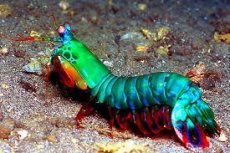New publications
Mantis crayfish will help improve cancer diagnosis
Last reviewed: 02.07.2025

All iLive content is medically reviewed or fact checked to ensure as much factual accuracy as possible.
We have strict sourcing guidelines and only link to reputable media sites, academic research institutions and, whenever possible, medically peer reviewed studies. Note that the numbers in parentheses ([1], [2], etc.) are clickable links to these studies.
If you feel that any of our content is inaccurate, out-of-date, or otherwise questionable, please select it and press Ctrl + Enter.

Mantis shrimps, which live at shallow depths in subtropical and tropical seas, have one of the most complex visions of any creature on earth. For example, humans can distinguish only three primary colors, while mantis shrimps see twelve colors, and they also perceive infrared and ultraviolet light and are able to distinguish between different polarizations of light.
At the University of Queensland, specialists studied these animals and concluded that cancer diagnostics can be significantly improved. In their research, scientists reproduced the properties of the eyes of these unique sea creatures within a regular camera, which allowed them to literally look through human body tissue. The scientists plan to implement similar technology in smartphones.
As already mentioned, the eyes of mantis shrimp are able to detect polarized light. In cancerous and healthy cells, such light is reflected differently, and specialists have managed to create a camera that converts signals that only the eyes of a crab detect into signals that are understandable to the human eye. As a result, specialists have obtained a system that is able to determine a diagnosis during the study of the activity of nerve cells or when diagnosing oncological diseases.
Currently, such equipment exists, but it is too heavy. Specialists intend to develop a small version of the camera that can shoot through tissue. Currently, a biopsy is prescribed to confirm an oncological diagnosis; the new system is suitable for studying neurons. In addition, during experiments with rodents, scientists managed to diagnose cancer in them at early stages.
Cancer is the most common disease today. Experts are not only developing new effective and safe methods of diagnosing diseases, but also ways to improve the effect of treatment. As shown by studies by scientists from the London College and the University of Southampton, berries can enhance the effectiveness of treatment for oncology. For example, chokeberry extract has the ability to quickly destroy cancer cells. Chokeberry berries contain a large number of vitamins, antioxidants, in particular polyphenols. The extract of the plant berries was tested on pathological cells in pancreatic cancer. During the experiment, some of the cancer cells were treated with a drug used during chemotherapy, and some with chokeberry extract in different concentrations. Scientists also tested the effect of the combined effect of chemotherapy drugs and chokeberry extract on cancer cells.
As a result, the extract showed its effect within 2 days, causing the death of cancer cells (concentration of 1 mcg per 1 ml). At the same time, in the maximum concentration (50 mcg), the extract turned out to be completely harmless to healthy cells. Small doses of the extract in combination with chemotherapy drugs showed amazing efficiency - a smaller dose of drugs was required for treatment, which reduced the likelihood of side effects.
In earlier studies, chokeberry extract showed good results in brain cancer studies. Scientists suggest that it is all about plant polyphenols, which can also be found in green tea, peanuts, turmeric, soybeans.

 [
[